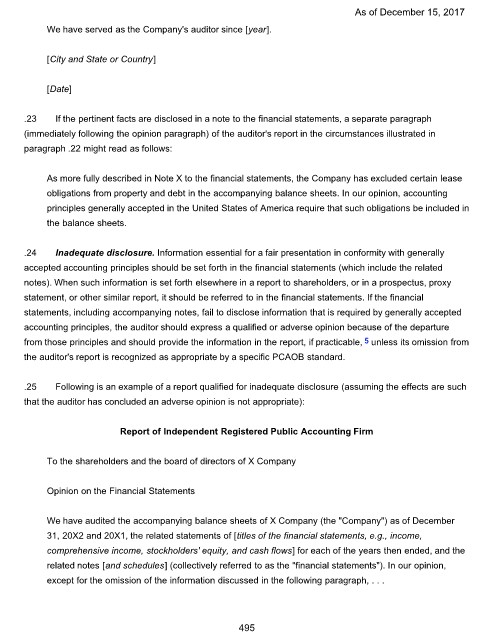Page 498 - Auditing Standards
P. 498
As of December 15, 2017
We have served as the Company's auditor since [year].
[City and State or Country]
[Date]
.23 If the pertinent facts are disclosed in a note to the financial statements, a separate paragraph
(immediately following the opinion paragraph) of the auditor's report in the circumstances illustrated in
paragraph .22 might read as follows:
As more fully described in Note X to the financial statements, the Company has excluded certain lease
obligations from property and debt in the accompanying balance sheets. In our opinion, accounting
principles generally accepted in the United States of America require that such obligations be included in
the balance sheets.
.24 Inadequate disclosure. Information essential for a fair presentation in conformity with generally
accepted accounting principles should be set forth in the financial statements (which include the related
notes). When such information is set forth elsewhere in a report to shareholders, or in a prospectus, proxy
statement, or other similar report, it should be referred to in the financial statements. If the financial
statements, including accompanying notes, fail to disclose information that is required by generally accepted
accounting principles, the auditor should express a qualified or adverse opinion because of the departure
5
from those principles and should provide the information in the report, if practicable, unless its omission from
the auditor's report is recognized as appropriate by a specific PCAOB standard.
.25 Following is an example of a report qualified for inadequate disclosure (assuming the effects are such
that the auditor has concluded an adverse opinion is not appropriate):
Report of Independent Registered Public Accounting Firm
To the shareholders and the board of directors of X Company
Opinion on the Financial Statements
We have audited the accompanying balance sheets of X Company (the "Company") as of December
31, 20X2 and 20X1, the related statements of [titles of the financial statements, e.g., income,
comprehensive income, stockholders' equity, and cash flows] for each of the years then ended, and the
related notes [and schedules] (collectively referred to as the "financial statements"). In our opinion,
except for the omission of the information discussed in the following paragraph, . . .
495

